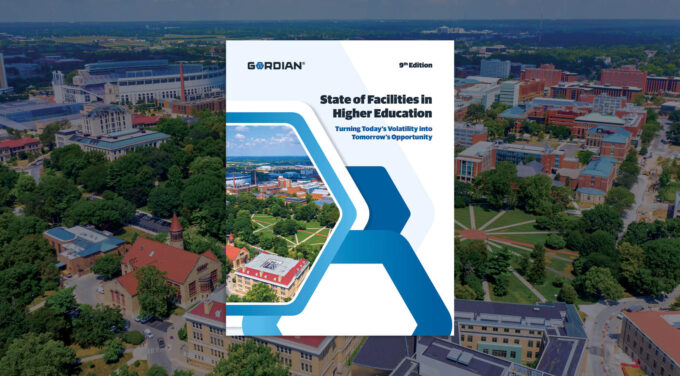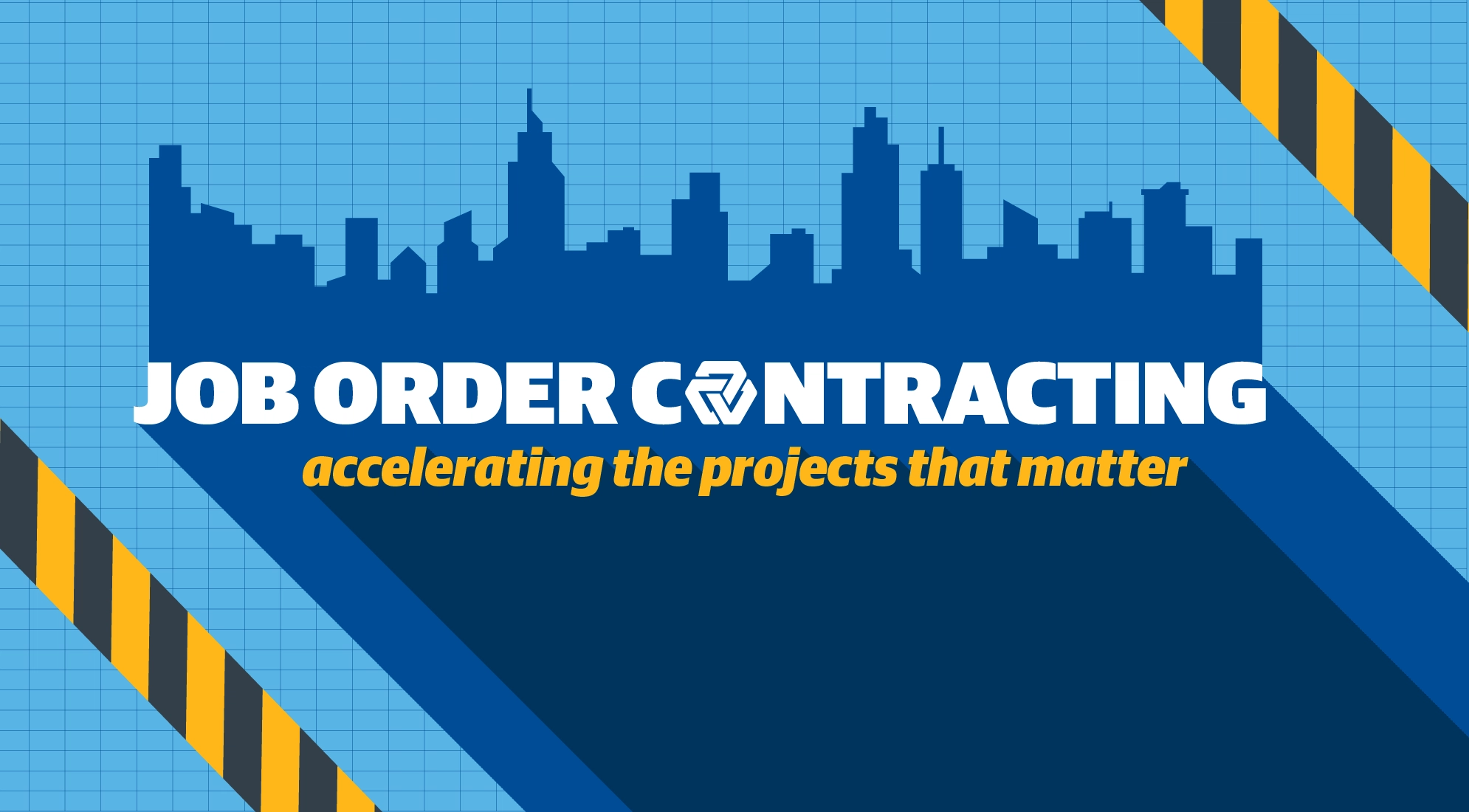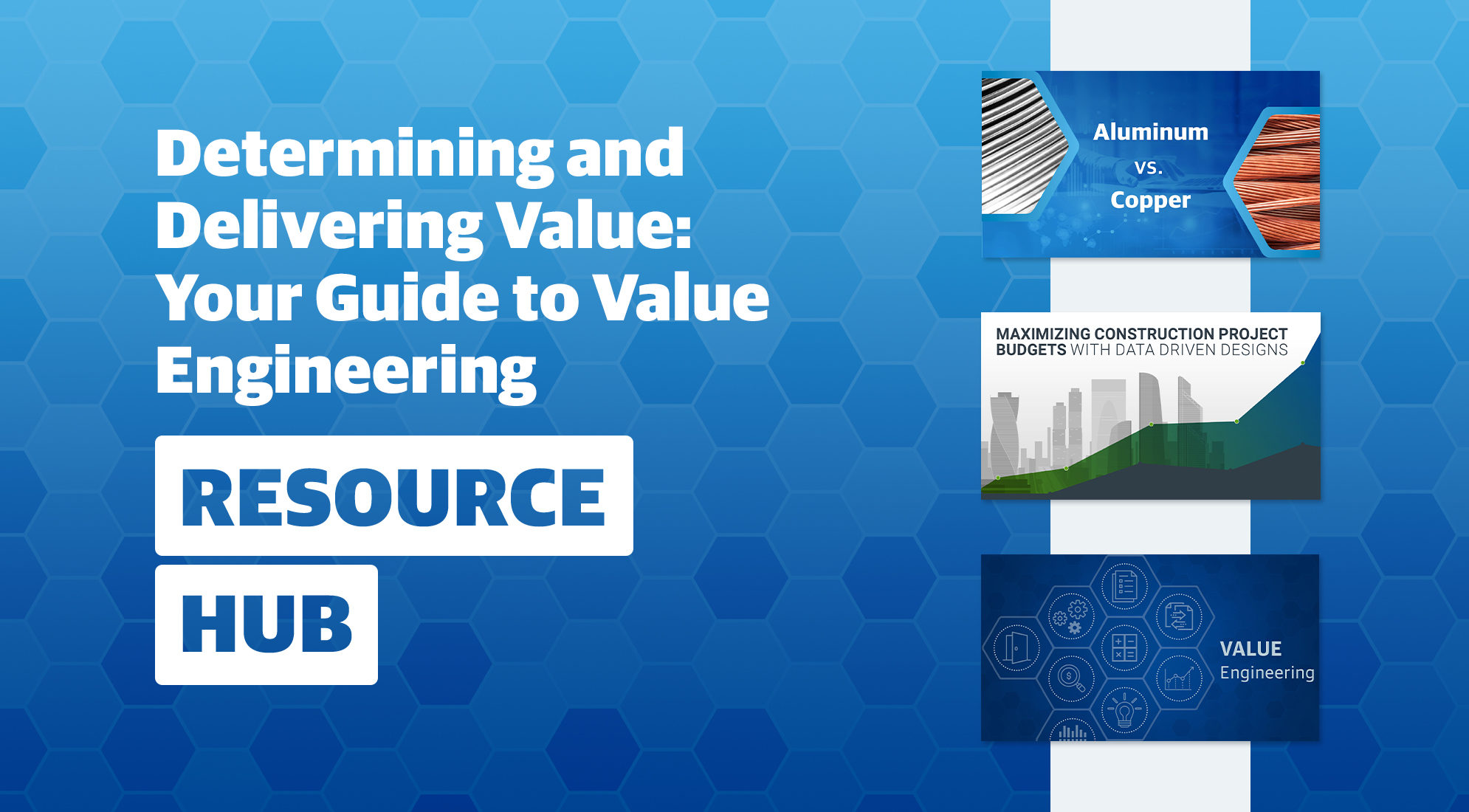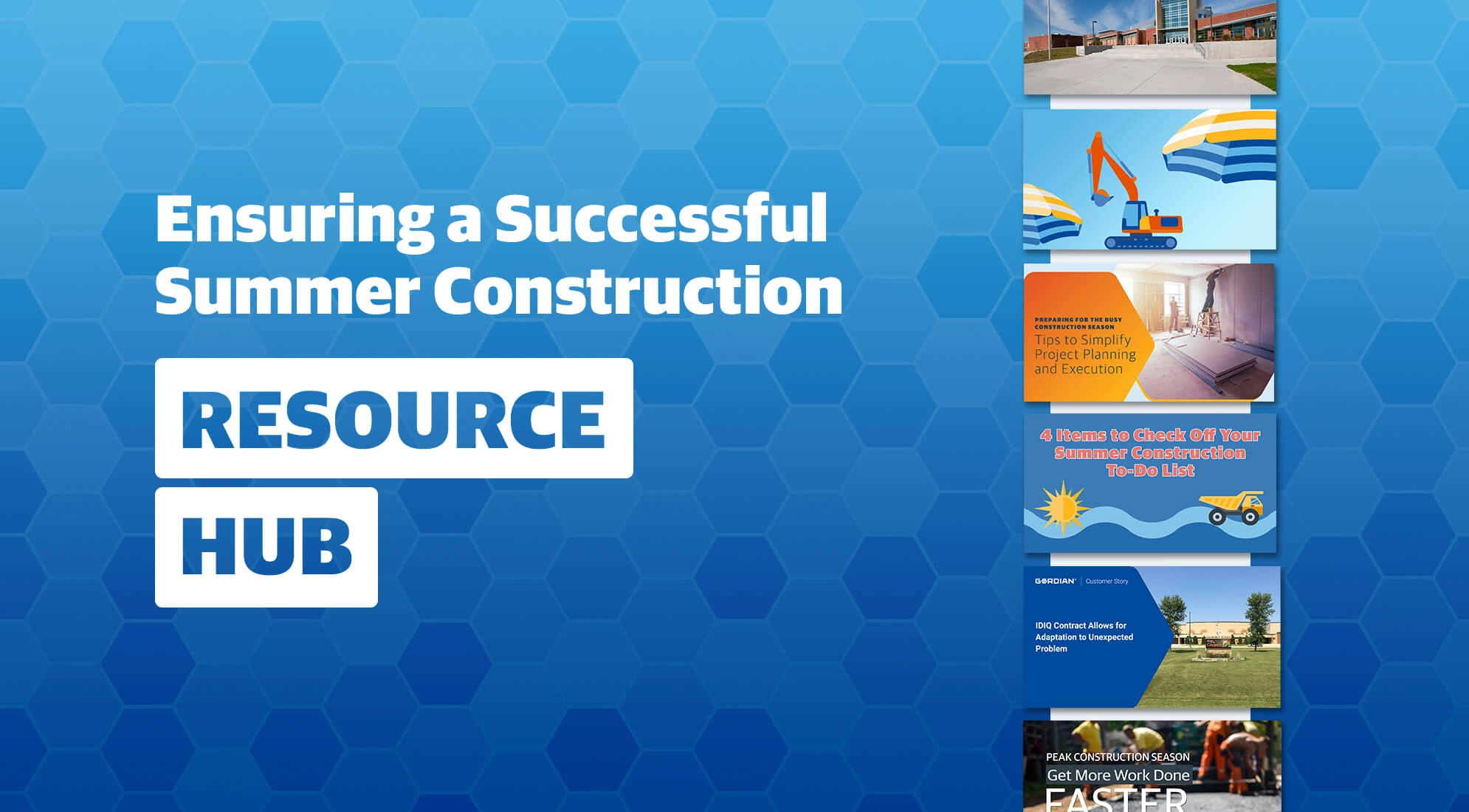Executive Summary
It is not a revelation to say that higher education has changed over the last two years. It remains unclear, though, whether the industry is adapting to its circumstances and evolving into something new or is simply showing resilience in the face of a monumental disruption. This year, data from Gordian’s database of 52,000+ higher ed facilities representing approximately 300 campuses across North America shows the continuation of familiar trends and some expected changes in response to a pandemic environment that has enveloped us all. To complement our facilities data with perspectives from the frontline, we partnered with APPA to survey facilities leaders concerning the current pressures they are under. 125 APPA members responded, and their experiences are captured in this report.
Here is a brief snapshot of what we have found.
Space: Growth continues to outpace enrollment, adding to operating and capital renewal burdens. Space is expanding at a time when our experimentation with remote learning is exploding, up as much as 150% during the pandemic. The confluence of these trends suggest institutions are out of touch with their own practices and the desires of a growing number of their constituents.
Capital: Capital spending fell modestly in fiscal year 20. That’s the good news. Here’s the bad news: Early FY21 data shows a dramatic drop in capital spending. Backlogs of need are growing correspondingly.
Operations: Operating budgets have plunged 9% since FY19. This decline far overshadows steady planned maintenance budgets. All of this is being exacerbated by accelerated personnel loss in an industry in which it is ever harder to find new talent.
Enrollment: The most recent data from the National Student Clearinghouse reports a 3% enrollment drop in the fall of 2021. Enrollment has been trending downward since 2012/2013 and birthrate data indicates the overall pool of traditional-aged students falls off considerably starting in 2026, with no uptick anticipated through 2038. The implications for the physical campus are profound and must be confronted.
Leadership: One of the most compelling responses to the recent APPA/Gordian joint survey is that 56% of facilities leaders indicated they have greater influence on campus since the pandemic began. Institutions would be wise to consider the contributions these leaders can make moving forward.
“We had some of our other senior VPs retire and the new ones leaned more on us for planning, decisions and input. As those recommendations paid off (in the sense of unfolding as we indicated they would), it resulted in increased trust and increased involvement in other planning, consulting and university operational decisions.”
– APPA survey response
This information indicates that the momentum of long-standing facilities trends is profound and enduring. The nimbleness with which schools pivoted in the spring of 2020 demonstrates a desire to thrive in the face of an imminent threat. The question before us is whether institutions are willing to adapt and confront the existential threat that’s been looming over them for decades: Physical infrastructure that will quickly drain valuable resource pools if not thoughtfully stewarded.
Short term disruptions are best understood within the context of longitudinal trend data. The present is no exception. The latest data does not broadly present seismic change, but there is change nonetheless. And that change gives us reason to pause and consider.
Aging Continues Unabated
The march of time is oblivious to current circumstances. Gordian’s data only affirms this reality. Historical waves of construction in higher education have produced a layering of lifecycle repair and replacement needs that will bear down upon campuses over the next 10-15 years.
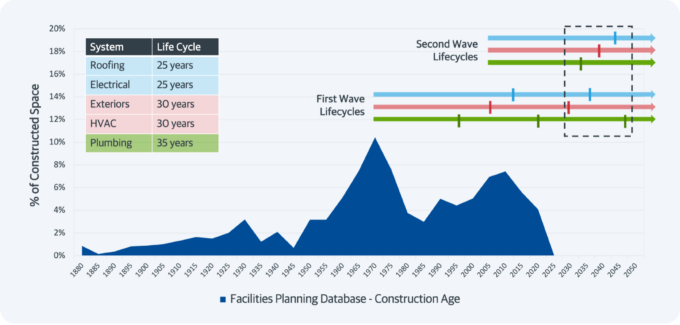
In April of 2021, Gordian joined APPA to report the level of capital investment backlog for higher education nationally. Despite annual investments of $36.8 billion in operations/maintenance/utilities, and a further $27 billion in capital investment of new and renovated space, higher education as a whole faces an estimated $112 billion in urgent deferred renewal. That number is only anticipated to grow larger with the coming life cycle demands of those two historic waves of construction outstripping the planned investments by campuses in existing space. The challenge of having this much potential future investment must force campuses to consider whether they will continue to need the spaces they currently have.

Renovation Age of Space
The measurement of renovation age, the age of buildings since their last major refresh, continues to be a valuable means for assessing the effective condition of a campus. Gordian’s latest data shows what we expect and have been predicting for some time now. 30% of buildings in our database are in the 10-25 year age group and the major systems of many of them will soon reach the end of their lives. Similarly, schools are debating what to do with the large portfolio of buildings first constructed in the 1960s and 1970s that are often subpar in terms of craftmanship and difficult to repurpose. These boom periods for campus expansion have long passed and now the bills are coming due. This wave of renovation needs will be cresting just as the enrollment cliff is hitting full stride, eroding access to students and the revenue necessary to address a deluge of needs.
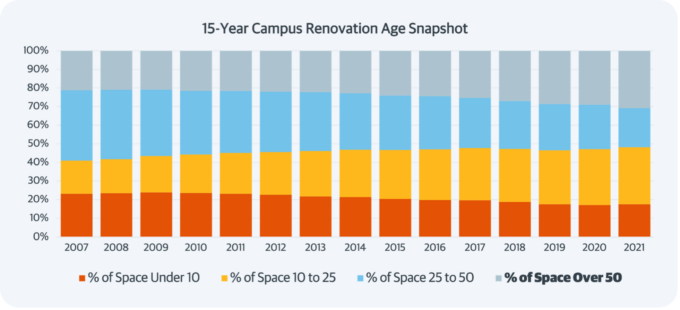
The Demographic Challenge
The student age population is shifting, and the implications of this shift are everywhere. Higher Education enrollment peaked at 21,253,000 students during the 2012/2013 academic year. For the 2019/2020 year, enrollment was 19,720,000. This 7% reduction represents a loss of 1.5 million students in just seven years. The National Student Clearinghouse Research Center report from January 13, 2022 reveals an additional enrollment drop of 5.1% between 2019 and 2021, representing 938,000 students. This winnowing away of the student body has an effect on the physical campus. In fact, 63% of the facilities leaders we surveyed anticipate an impact from the expected enrollment drop by 2025-2026.
The discussion of the impending mid-decade enrollment cliff has been front and center since Professor Nathan Grawe popularized it in his book, “The Agile College.” Professor Grawe sounded the alarm about declining birth rates and a thinning of the college-aged population beginning in 2026 and extending into the future.
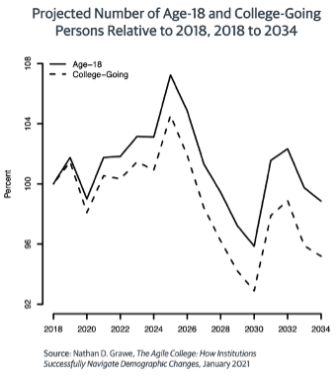
The depth of the enrollment decline has been extended. The data in “The Agile College” stopped in 2017; that was a pre-pandemic world. Birthrate data from the Center for Disease Control has shown a continued drop each year since, including an astonishing 4% fall in 2020. This extends the enrollment decline until 2038. The implications for the built environment on all but a very few college campuses are clear: There will be more space than is necessary to deliver the current program.
There are examples around the country where growth in population and the growth in collegeaged students has continued. But even states like Florida, where the population is increasing through a combination of migration and natural growth, saw a 26% enrollment decline at state colleges over the last decade. With all we know about population trends based on Grawe’s work, even those schools with near-term growth, which the data indicates could be many, should be careful about expecting those trends to continue. With few exceptions, it simply cannot be assumed that students will continue to be drawn to the schools that are thriving in today’s environment.
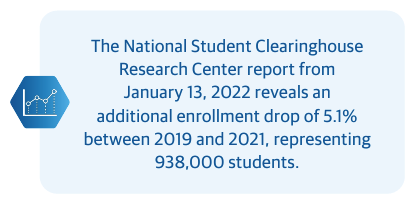
The Intersection of Space and Enrollment
Large scale capital investment and divestment decisions are often slow to change, even during pandemics. The most recent data reflects that reality, as space growth has continued, despite downward trends in enrollment and increasing facilities backlogs. While the rate of campus expansion has tempered slightly over the past several years, the significant increase in space over the past decade remains an acute financial liability.
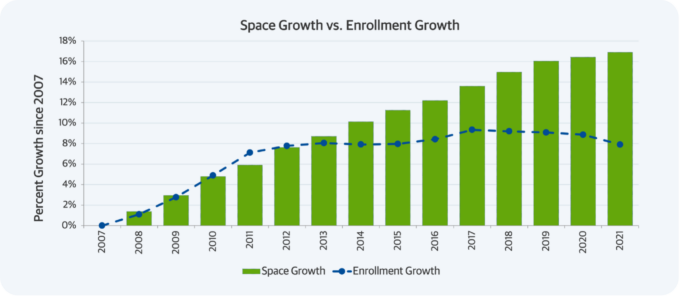
The stress that higher education is feeling today from the backlog of capital needs for buildings and infrastructure will not abate for years to come, even if new construction had stopped a year ago. And yet, despite all the forces at work against campus facilities, a short-term leveling off of space growth relative to enrollment is an important first step in a long journey to secure the future of any campus.
The implications of the widening gap between enrollment and space have been taken up in numerous venues, but they bear repeating. Fewer students available to all but the most selective institutions will reduce the available dollars to operate cash-strapped campuses. Concentration of students toward name-brand national institutions – where value is perceived to be both durable and high – will add extra stress to regional public and private schools lacking the endowment resources, the major donor base and the public financial backing to weather extended reductions in tuition revenue. This is not a warning about some far off, dystopian future. This is where we are headed. Analysis of enrollment trends identified in the Gordian/APPA survey show that Masters/Baccalaureate and Associates institutions faced the sharpest enrollment reductions and will struggle to keep the doors open if they do not adapt to their current reality.
The evolving mix of students from different social, racial and ethnic backgrounds will produce a shift in the interest in types of schools (2-year, 4-year, specialty, etc.), as well as place new demands on schools of all types to provide the physical, social and pedagogical infrastructure necessary for student success.
Space and the Remote Campus Experience
Campus space use has been transforming for some time; the pandemic only served to accelerate the transformation. For a while in 2020, we didn’t use space at all. Every institution adopted a remote model initially and many would claim that model persists in some form across their campuses today.
The resilience of the educational experience in a remote format has been surprising to many, but the sheer scale of its adoption made remote teaching and learning a viable possibility. According to the National Center for Educational Statistics and as reported by Inside Higher Ed, from 2019 to 2020 the number of students enrolled exclusively in distance education courses made a 150% leap. That remote bias persisted into the spring of 2021 with only 18% of schools fully or primarily in person, as reported by The Chronicle of Higher Education and the College Crisis Initiative based at Davidson College. The change to remote access wasn’t just for teaching and learning. Administrative departments discovered that employees were remarkably productive away from the office.
Supporting remote learning and working comes with considerable expense if undertaken earnestly. Dollars directed toward programmatic priorities will only further diminish the available funding to care for physical campuses straining under deferral and age.
The anticipated shortfall in capital investment dollars started to reveal itself in FY20 with a modest reduction of 2.7% in capital investment, due in large part to a 12% reduction in recurring stewardship dollars. Capital investment has plummeted dramatically since. Preliminary 2021 data bucks the long-term trend with a year-over-year investment reduction of 19%, as major capital projects were slowed or halted, and recurring stewardship expenditures dipped further.
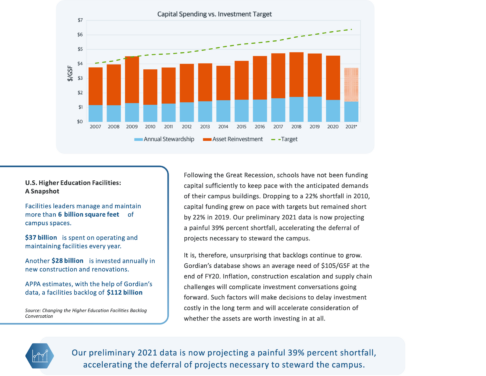
The Great Reprioritization
Year-over-year operating expenditures dropped 4% from 2019 to 2020, a decrease produced by a 10% drop in energy spending and a mild daily service compression. The early FY21 data reflects the experience of those people working on campus who saw a reduction in daily service activities, planned maintenance and utilities expenditures. In total, these expenses are down 9.5% from FY19. Additionally, 41% of facilities leaders reported their operating budget has been reduced over the last year and 44% indicate it has remained static.
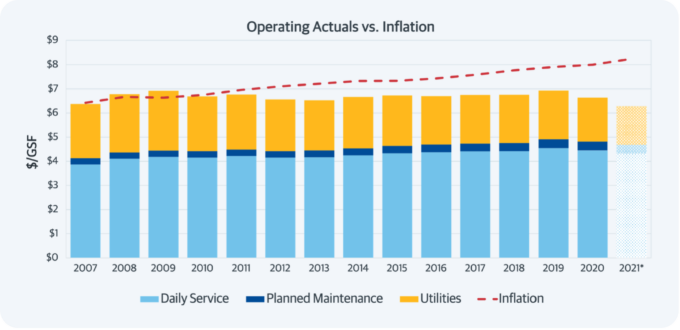
Those reduced expenditures have also been contributing to the on-campus pandemic response. Daily service total investment was relatively unchanged for FY20, though it is important to recognize that the character and quality of that spending changed late in the year as money was redirected to enhanced cleaning, distancing, HVAC modifications, signage and myriad evolving campus demands. While some of these efforts were partially offset by federal relief dollars, few expect that such funding covered every effort.
Planned maintenance continued its steady growth, representing a modest 5.5% of total operating expenditures. This continues a ten year run without a reduction, yielding a 42% increase over that time. This encouraging trend indicates that facilities leaders not only value this investment but are getting support from administrations to sustain it during challenging times. Historical data continues to indicate that every dollar invested in planned maintenance is worth nearly three times that much in daily service impact. Still, operating expenditures only makes sense when coordinated with space and capital decisions.

Fewer Hands, Heavier Burden
FY20 began with a slight increase in staffing counts across Gordian’s database, resulting in modest improvement in coverage area for maintenance workers. To their credit, a great many institutions realized the importance and essentiality of their facilities employees and resolved to hold onto staff for as long as possible. And, perhaps naively, nearly everyone hoped the pandemic would be a brief hurdle.
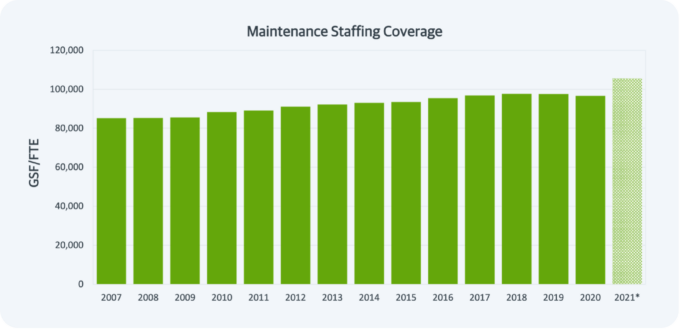
But everything changed in FY21, as a combination of furloughs, layoffs, voluntary retirements and the Great Resignation changed the higher ed facilities workforce. Preliminary data for FY21 shows an average workforce reduction of 8%. Anecdotal feedback on our work would suggest that the situation is not improving. The APPA member survey revealed that 55% of operational staffs will shrink this year. This means that while campuses are expanding, the pool of people charged with stewarding them is constricting. The results are gaps in knowledge, reductions in available time for all but the most basic of work and an unclear vision of what organizations will look like in the future.
If there is anything we are coming to appreciate in this pandemic, it is a collective desire to take control amidst the many forces which seem to be wresting it from us on a regular basis. The desire to take action is strong and admirable, but how to act responsibly and effectively is up for debate. The following are select recommendations for pressing forward.
Plan Coherently
Creating and expanding the intellectual environment has long been a hallmark of academic institutional identity. These efforts, though thoughtful, sometimes produce unwieldy plans designed to ameliorate the perceived problems of the greatest number of people and rely on the existence of a stable educational marketplace. For generations, this stability was a given, a condition taken for granted. Circumstances have changed and that reliably stable market of students has become volatile. Whether everyone within institutions recognizes this fact remains to be seen.
Truly thoughtful consideration happens within the kind of integrated planning championed by organizations like The Society for College and University Planning, but a few tactics will serve any campus well as a starting point.
4 Techniques for Coherent Planning
1. Question the status quo
The pandemic has upended predictability in education, and it is more challenging than ever for schools to think and act long term. The pandemic has also forced a change in the momentum that has kept schools maintaining so many familiar practices – even unhealthy ones. Unpredictability can make all but the most adventurous leaders hesitate and wait for what feels like a safer time to make a move. But now is not a time for stasis. The world has seen how quickly schools can adapt, and they should continue to engage in the activities that created those adaptations, even if they fly in the face of the status quo.
2. Leverage available data and fill in your data gaps
If your latest Facility Condition Assessment (FCA) has been sitting on a shelf, it’s time to dust it off and see what it has to tell you about the state of your facilities. If you don’t have recent information about the effectiveness of your operational and capital investments, gather it or find a partner who can help you do so.
This objective data, divorced from the tension-filled pressures of the moment, provides a stable starting point for decisioning. Campus colleagues will likely be on their own hunts for data, some of which may challenge your existing assumptions. Be open to this information and its potential implications. Scrutinize it, question it, but be open to letting the data reframe how you’ve historically viewed your campus.
3. Engage all stakeholders
It’s time to tear down the old silos once and for all. The pandemic has revealed opportunities to reimagine how departments use space and engage with students and each other. Facilities leaders are stepping into this new collaborative environment. According to this year’s APPA survey, 56% of facilities leaders say that they have more influence today than before the pandemic. That influence can help schools rethink how departments operate and deliver the quantity and types of spaces their campuses demand.
4. Embrace progress over perfect solutions
Resist the urge to get everything right all at once. You can’t create a perfect plan quickly, if ever, but action is necessary now. Set attainable incremental goals like gathering facilities data, outlining institutional priorities and matching priorities with needs. Reach those goals, then reconvene and begin the process anew. Don’t rest. Make progress.
“The campus has seen more of our capabilities, more of just how much we do on a day-to-day basis, how resilient we are and our capability to take on additional responsibilities as they arise and change.”
– APPA survey response
Support the Campus Community with Technology
APPA’s Productive, Smart Buildings initiative is creating a decision-making framework to optimize human productivity by investing in the built environment and smart technologies. This initiative and others that leverage technology can improve investment strategies for facilities and finance leaders in service of the primary institutional mission.
In an even larger sense, technology continues to offer opportunities to reconsider the way campuses operate and deliver education. Some schools use it maximally, while others are using it simply to supplement traditional experiences.
As recently as January of 2022, Dartmouth College has affirmed the importance of in-person teaching and learning for its community even in the face of pandemic surges. Provost Katz noted, “Being in-person, both for learning and for out of the classroom experiences, is so important to the learning experience and student mental health — and frankly, to everyone’s mental health.” While Dartmouth professors are fully prepared to move online, remote instruction will be used by exception and not the rule. The traditional campus will remain at the core of the school’s identity.
Quinnipiac University has taken the opportunity to make sure that classrooms would function for remote/hybrid teaching and learning not only during the heart of the pandemic, but also going forward. This flexibility has its perks. The university is thus positioned to explore any number of different teaching and learning modalities as well as open programs to a variety of different types of learners.
Southern New Hampshire University has long leveraged technology as it continues to be a leader in innovative pathways to learning, while simultaneously understanding the importance of place on its modest campus. Technology connects students across the globe with a sophisticated and personalized support system and brings them together to form a vast community that is very different than its traditional counterparts. While continuing to upgrade the small traditional campus, SNHU reaches hundreds of thousands of students annually using technology and requires a network of dynamic and flexible spaces in New Hampshire to support this learning model.
Recently, Arizona State University announced its initiative through the Thunderbird School of Global Management to educate 100 million students by 2030. With nearly 80,000 students on its physical campuses and over 130,000 students overall, this goal would extend programs to 750 times as many students and effectively engage five times as many students as were enrolled in all of U.S. Higher Education in 2020. A stretch goal for sure, ASU’s initiative speaks to the impact technology may soon have on the shape of higher education.
None of these technological deployments are possible without a core institutional identity. The key is embracing the connections between technology and the physical campus and flexibly reimagining what the campus and the campus culture will look like in the future and along the way. It is vital for every campus – no matter how much or how little they embrace technology – to ensure that the spaces and the people who care for those spaces are prepared to handle the adaptations that technology is bringing to campuses around the globe.
Invest creatively in your future
Signs are everywhere that facilities investment strategies will and should continue to evolve. Creative investment is not always innovative and forward-thinking. It can also be adaptive. The following are a number of creative adaptations to strategies which can be deployed in the short-term to invest in the integrity of your facilities organization and the institution it serves.
Develop Talent
While the struggle to find employees has risen to the top of the priority list for many facilities leaders, most would be hard pressed to say that hiring is their top investment focus. Jim Jackson, Associate Vice Chancellor of University Operations at the University of Nebraska has indicated that there is no higher priority than the development of his team. “We need to look at retention and not just recruitment right now. Investing in the basic knowledge and leadership skills of our people means that when that time comes when things get rough, our people lean in and have the knowledge, wherewithal and drive to get us through. The return on our investment in them is visible right before our eyes.” Leaders recognize they will lose talented people, but if they build a culture where smart and talented people come to grow, they will always be able to find new people who want to contribute and learn about the rapidly evolving technologies involved in modern facilities management.
“Investing in the basic knowledge and leadership skills of our people means that when that time comes when things get rough, our people lean in and have the knowledge, wherewithal and drive to get us through. The return on our investment in them is visible right before our eyes.”
– Jim Jackson, Associate Vice Chancellor of University Operations, University of Nebraska
The most successful leaders are creating an environment where people come and stay for a long time because of the kind of work that they are doing, the chance to grow and the creative people that they get to work with. You can do that on your campus, too, and fight the talent challenge not necessarily by spending money but by establishing the kind of environment where people want to work. The University of Nebraska does that through intense use of training resources and encouraging participation in relevant professional associations and technical organizations. A similar investment in your people can serve as insurance against an uncertain future.
Reimagine Structure
The facilities organization of two years ago was built around a different reality than the facilities organization of today. There is no reason that the organization itself shouldn’t learn from the experience and adapt as well. Organizations that have been split between operations, planning and capital would be wise to reconsider the benefits of connections that have recently improved coordination in an everchanging pandemic environment. Those connections will be necessary as the institution reconsiders its priorities in a world with fewer students, constrained resources and an increasingly space-rich environment. Even for those who are moving forward with fewer impacts from the outside world, using this moment to optimize organizational communication and function will preserve the advantageous position being held today and desired tomorrow.
Readjust Priorities
This recommendation looks obvious on the surface. But honest reflection by most facilities and finance leaders reveals that much activity is based on reaction to day-to-day needs and aspirations, not strategic priorities. One need only look at the operational investment profile (see page 9) or the space/enrollment trends (see page 6) for evidence. Prioritizing investment and related work around key considerations would do the investment strategy well. Those key considerations include:
- Eliminating space expansion beyond the ability to care for it properly.
- Focusing capital investment on property that is part of a long-term plan (and if there isn’t a recently updated plan, investing in that effort).
- Directly investing in people to retain them and engaging them in the work to transform the campus.
- Optimizing use of materials and energy to reduce costs and operate more sustainably.
Setting facilities priorities and executing on them can be a strained experience, particularly in the pressure cooker we’re living in. It can help to get an outside perspective, someone to referee tense conversations and focus a planning group on what’s important. Campus leaders should seek out partners with experience helping schools understand their facilities portfolios, creating investment goals that move institutions toward their long-term plans and building a custom scoring methodology that ranks projects and balances facilities investments. This consultative approach assists in the creation of, and commitment to, a multi-year capital plan.
Gordian offers versatile capital planning solutions to help you create actionable, mission-focused investment plans that ensure each dollar is allocated towards the highest priorities
“What’s past is prologue.” This Shakespearean phrase from “The Tempest” is followed by the lesser quoted line, “What to come, in yours and my discharge.” While the initial phrase is often used to suggest that the past has shaped our present circumstances and future destiny, the subsequent sentence asserts that the past only sets the stage for the choices we can – and must – make today. Facilities stewards are faced with a moment in time when both understandings can feel true at once.
Historic capital investment and operational strategies have established within the built environment a fixed reality that shapes the character of the campus community and weighs heavily on the financial realities of the institution. What’s past really is prologue.
But the future choices remain ours. The pandemic has unlocked the doors to more possibilities than ever before. There’s more data available to us than any point in history. What remains is a matter of will. Will we evolve and shape the future, or will we do what we’ve always done and leave the shaping of the future to others?
We believe strongly in the potential of the former and see great risk in the latter. It’s time to plan coherently, leverage technology and invest creatively. It’s time to adapt.


